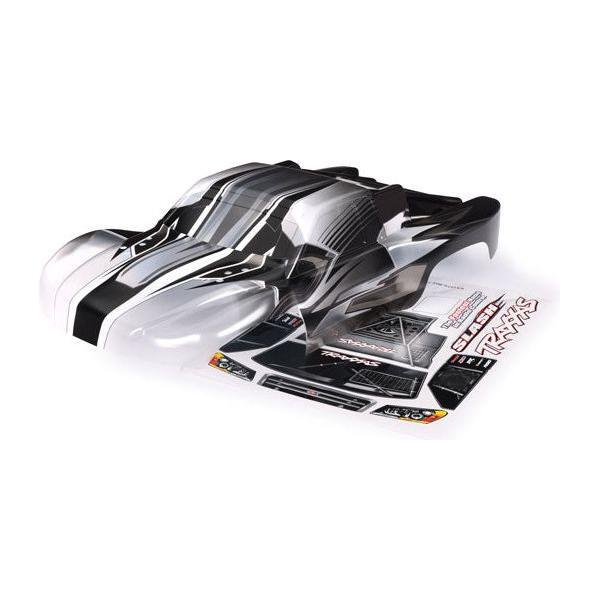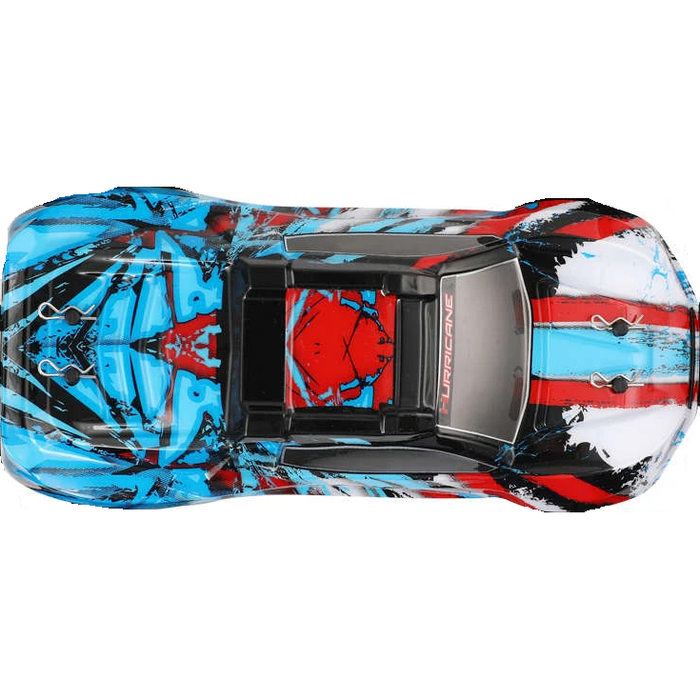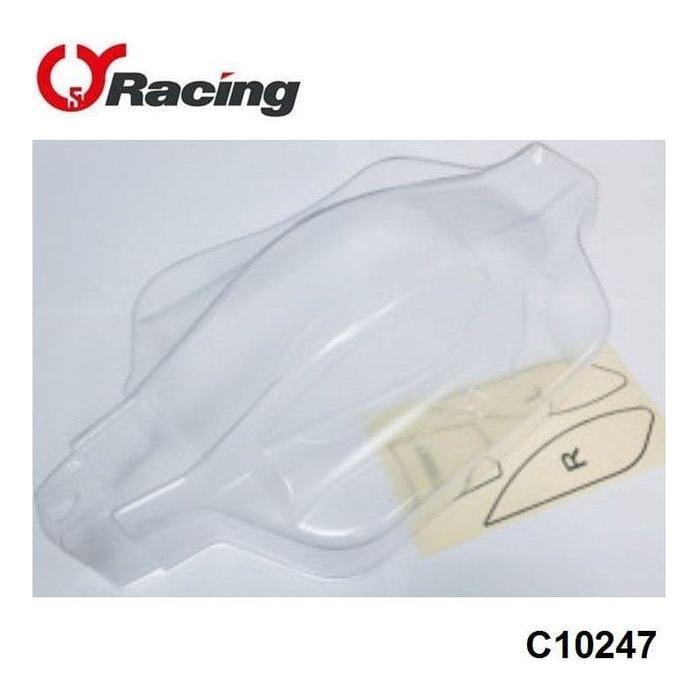Behind the Scenes: Designing the Perfect RC Body Shell for Downforce
Master the art of aerodynamics to keep your RC car glued to the track
G'day RC enthusiasts! Ever watched ya car slide off at high speed and wondered what went wrong? Designing the perfect RC body shell ain't just about making it look ripper — it's about gettin' that sweet spot between looks and performance that'll leave your mates in awe. Every single curve, vent, and millimetre of clearance plays a massive role in how your little beast grips the road when you're pushin' the limits.
From the basic physics that'll make sense to anyone (promise!) to the nitty-gritty of materials and manufacturing methods that separate the weekend cruisers from the podium finishers. Whether you're just starting out or you've been bashin' around tracks for donkey's years, there's something here to take your RC game to the next level. And don't worry — we've linked you to all the custom paints, stencils, and on-road kits you'll need to build your next aerodynamic masterpiece.
| RC Body Shell Downforce at a Glance | |
|---|---|
| Understanding Downforce | The physics behind what keeps your car planted, plus how it affects handling at different speeds |
| Design Elements | Wings, diffusers, side skirts and other features that generate downforce without excessive drag |
| Material Choices | Polycarbonate vs ABS, thickness variations, and how they impact performance and durability |
| Testing Methods | DIY techniques to measure and improve your shell's aerodynamic performance without fancy equipment |
| Custom Modifications | Practical tweaks and adjustments to enhance downforce on existing shells |
| Top Performers | Our recommended body shells for different racing disciplines and scales |
Understanding Downforce in RC Car Design
When you're flying around a corner at full throttle, what keeps your RC car from yeeting itself straight into the barriers? That's right—downforce! It's that magical aerodynamic pressure that pushes your car towards the ground as air flows over the body. Think of it as nature's own set of invisible hands holding your car down when physics wants to send it flying.
The science ain't that complicated, really. As your car moves, air splits and travels both over and under the vehicle. The shape of your body shell creates different air pressures—when there's higher pressure above and lower pressure below, your car gets pushed down. Simple as!

But here's the rub—unlike the pros in Formula 1 with their fancy wind tunnels and million-dollar computers, us RC hobbyists gotta rely on experience, clever design choices, and a bit of trial and error. Too much downforce and your car becomes a slug in a straight line. Too little and you'll be picking your car off the grass more often than actually driving it!
Different racing disciplines need different downforce setups:
- On-road racing needs balanced downforce for high-speed cornering stability
- Drift cars often sacrifice some downforce for controllable slides
- Rally and off-road require adaptable aero that works on varying surfaces
For beginners looking to experiment with downforce, our on-road racing kits come with body shells that already have decent aero properties to get you started. Trust me—you'll feel the difference between a basic shell and one designed with proper downforce consideration the moment you hit your first corner at speed!
Design Fundamentals: Shapes That Generate Grip
Not all body shells are created equal when it comes to downforce. Even small changes in shape can make massive differences in how your car handles. Let's break down the key design elements that separate the showpieces from the race winners:
Front End Design
The front of your RC body shell sets the tone for all airflow over your vehicle. A well-designed front end will:
- Split airflow efficiently to reduce drag
- Create a stable platform for front-end grip
- Channel air to other downforce-generating elements
Most high-performance shells feature a low, sloped nose profile that reduces frontal area while directing air up and over the car. This is why touring car shells often look so sleek and pointy—they're designed to cut through air with minimal disturbance while setting up the rest of the airflow path.
Racing Tip:
When installing your shell, make sure there's minimal gap between the front bumper and the shell itself. Large gaps disrupt airflow and reduce the effectiveness of your shell's aerodynamic design.
Wings and Spoilers
The rear wing might be the most obvious downforce generator—and yeah, size matters—but so does position, angle, and profile. A proper wing creates a pressure differential that literally sucks the rear of your car onto the track.
Let's look at different wing types and what they do:
| Wing Type | Best For | Downforce Level |
|---|---|---|
| Single Plane | High-speed tracks, lower drag | Moderate |
| Dual Element | Technical tracks, more grip | High |
| GT Style | Scale realism, balanced performance | Moderate to High |
| Integrated Spoiler | Drift cars, street appearance | Low to Moderate |
Many of our 1/10 on-road bodies come with multiple wing options so you can experiment with what works best for your driving style and track conditions.
Side Skirts and Underbody Design
One area that often gets overlooked is the humble side skirt. These aren't just there to make your car look lower—they actually seal the low-pressure area underneath your car, enhancing what engineers call "ground effect." This is why you'll see many high-end 1/8 scale shells with pronounced side skirts that almost touch the ground.

The flatter and smoother the underbody of your shell, the better the ground effect works. Some racers even add small diffuser details to the rear underbody to further enhance this effect. If you're running on smooth surfaces, this can make a huge difference in cornering speed.
Materials & Build Quality: Choosing the Right Foundation
The substance your shell is made from affects not just durability, but also how it performs aerodynamically. Let's face it—a shell that flexes under air pressure isn't going to maintain its downforce-generating shape, is it?
Polycarbonate vs ABS: The Great Debate
Most RC body shells come in either polycarbonate (lexan) or ABS plastic. Each has its strengths when it comes to aerodynamic performance:
| Material | Aero Advantages | Aero Disadvantages | Best For |
|---|---|---|---|
| Polycarbonate (0.5mm - 2mm) |
Lightweight, can be made with varying thickness, easy to modify | Can flex at high speeds, potentially changing aero properties | Most racing applications, especially 1/10 scale |
| ABS Plastic | Rigid, maintains shape even under high air pressure | Heavier, harder to modify after manufacturing | Scale realism, larger 1/8 scale models |
The thickness of polycarbonate makes a massive difference too. Thinner shells (0.5-1.0mm) are lighter but flex more, while thicker shells (1.5-2.0mm) hold their shape better at speed. Many pro-level shells use variable thickness—thicker in areas that need rigidity for downforce, thinner elsewhere to save weight.
For serious racers, our premium body shell collection includes options with reinforced areas specifically designed to maintain aerodynamic integrity at race speeds.
Manufacturing Quality Matters
Not all shells are made equal, even when using the same materials. Key quality factors include:
- Mold Precision: Sharper details and cleaner lines create more consistent airflow
- Cut Quality: Rough edges disrupt air and reduce downforce
- Mounting System: Secure mounting prevents flex and vibration that can alter aero properties

Testing & Tuning for Maximum Grip
So you've got your fancy new shell—but how do ya know if it's actually working? Unlike full-size motorsport, we don't have telemetry and wind tunnels at our disposal. But there are still practical ways to test and tune your shell's downforce:
The Straight Line Speed Test
Find a long, smooth stretch and do speed runs with different shells or wing configurations. If your car becomes unstable or "light" feeling at top speed, you probably need more downforce. A well-balanced shell should feel planted even at max throttle.
The Corner Speed Challenge
Set up a consistent corner and see how much speed you can carry through it before losing grip. Higher corner speeds generally indicate better downforce. Try different wing angles and body positions to find the sweet spot.
For consistent testing, mark your ride height before and after changes. Downforce will actually compress your suspension slightly at speed, affecting handling characteristics.
DIY Flow Visualization
Wanna see airflow patterns with your own eyes? Here's a little trick the pros use: attach small pieces of wool or string (about 1-2cm long) to various points on your body shell with small pieces of tape. Drive at moderate speed and have a mate film it—the string will show you exactly how air is flowing over your shell!
Key areas to check include:
- Front splitter and bumper area
- Side skirts
- Behind wheel arches
- Wing and spoiler elements
For those serious about performance, investing in a set of quality RC tools will make adjusting your shell's position and wing angles much easier.
Customisation & Aesthetics Without Compromising Performance
Let's be honest—we all want our RC cars to look mint while performing well. The good news? You can have both if you're smart about it.
Paint and Finish Considerations
Paint adds weight, and weight is the enemy of speed. Here's how to keep your shell looking sharp without sacrificing performance:
- Use RC-specific spray paints designed to be lightweight
- Apply thin, even coats rather than thick layers
- Consider leaving some areas unpainted (like the roof) to lower the center of gravity
For those racing seriously, a simple single-color scheme with minimal details will be lightest, but for shelf queens and casual racers, our body shell stencils can help you create detailed designs without piling on the grams.
Performance-Enhancing Modifications
Some customizations can actually improve downforce while making your shell unique:
- Custom Canards: Small winglets at the front corners can increase front-end grip
- Roof Scoops: Not just for show, these can reduce internal pressure in the shell
- Custom Diffusers: Adding a textured or finned pattern to the rear underbody enhances ground effect
| Performance-Focused Customisation Options | |
|---|---|
| Custom Vents | Add strategically placed vents to reduce lift and cool electronics |
| Extended Side Skirts | Enhance ground effect by sealing underbody airflow |
| Custom Wing Gurney Flaps | Small vertical tabs on wing trailing edges for increased downforce |
| Body Height Adjustment | Fine-tune shell position relative to the ground for optimal aero |
Remember, any modification should be done with balance in mind. Adding downforce to just the front or rear can make your car unpredictable. Our racing kits often include adjustment options that let you fine-tune this balance.
Top Picks: Performance Shells That Deliver
With all this knowledge in mind, let's look at some standout performers from our collection that combine excellent aerodynamics with quality construction:
For 1/10 Scale Racers
The 1/10 scale category offers the widest range of aerodynamically advanced shells. Our top picks include:
- Touring Car Shells - Purpose-built for grip and stability at speed
- GT Racing Bodies - Balance scale realism with functional downforce elements
- Formula Bodies - Open-wheel designs with highly optimized wings and diffusers
For 1/8 and 1/7 Scale Monsters
Larger models need more downforce to stay planted due to their increased mass and power. The best options in our 1/8 scale collection feature:
- Reinforced polycarbonate that resists flexing at speed
- Larger, more aggressive wing packages
- Comprehensive underbody aerodynamics
For the ultimate in large-scale performance, check out our 1/7 scale bodies designed specifically for high-powered applications.
Brand Spotlight
Certain manufacturers have really nailed the balance between looks and aerodynamic function:
- Tamiya - Known for scale realism while maintaining good aero properties
- Protoform - Racing-focused designs with wind tunnel testing
- Yokomo - Drift-oriented bodies with balanced downforce characteristics
No matter which you choose from our body shell collection, remember that proper mounting and alignment is crucial for realizing the shell's full aerodynamic potential.
Frequently Asked Questions
How much downforce do I really need for my RC car?
It depends on what you're doing with your beast! For casual bashing around, minimal downforce is fine. For competitive racing, you'll want enough to keep your car planted without killing your top speed. As a rule of thumb, you should be able to take corners at about 70-80% of your straight-line speed without feeling the car get light or wash out. If you're running a proper race kit, start with the manufacturer's recommended wing setup and tweak from there.
Will adding vents to my shell improve downforce?
Contrary to what many think, most vents actually reduce downforce! They're mainly for cooling your electronics or adding scale realism. Strategic vents can help balance pressure inside the shell, but random holes will just disrupt airflow patterns. If you're racing seriously, only add vents where the manufacturer designed them or where you've properly tested their effect. For street bashers and scale builds, feel free to add vents wherever they look ripper on your body shell!
Can I modify an existing shell to improve downforce?
Too right you can! Here are some quick mods that work a treat:
- Add a small Gurney flap (5mm strip) to the trailing edge of your wing
- Extend your side skirts closer to the ground using thin lexan strips
- Adjust your shell mounting position (lower usually means more downforce)
- Add small canards to the front corners if you need more front-end bite
- Make sure all mounting points are secure to prevent flex at speed
Just remember to test each change individually, and keep things balanced front-to-rear. For more serious mods, check out our speciality RC tools that make precision work much easier.
Does paint weight affect aerodynamics?
You betcha it does! Heavy paint jobs don't just slow you down from added weight—they can also change how your shell flexes under air pressure. If you're racing competitively, use the lightest RC spray paints you can find and go easy on the layers. For shelf queens or casual bashers, don't stress too much—a few extra grams of gorgeous paint won't ruin your day out!
Conclusion
There ya have it, mates—the inside scoop on creating RC body shells that actually keep your wheels where they belong... on the track! Whether you're a weekend warrior or gunning for podium finishes, understanding the science behind downforce will transform how your car handles when you're pushing the limits.
Remember, the perfect shell balances form and function. Those swoopy lines and aggressive wings aren't just for show—they're working hard to harness the invisible power of air pressure. Start with quality materials, pay attention to the details, and don't be afraid to experiment with different designs to find what works for your driving style and track conditions.
Final Thoughts:
At the end of the day, a ripper body shell is one that keeps you confident behind the controls while looking bloody fantastic doing it. So grab yourself a quality body shell, make it your own with some thoughtful mods, and enjoy the satisfaction of watching your mates' jaws drop when you take that high-speed corner without even lifting off the throttle. Happy racing, and remember—in the world of RC, staying down means going faster!
 is here! Shop now, pay later in 4 easy installments
is here! Shop now, pay later in 4 easy installments

